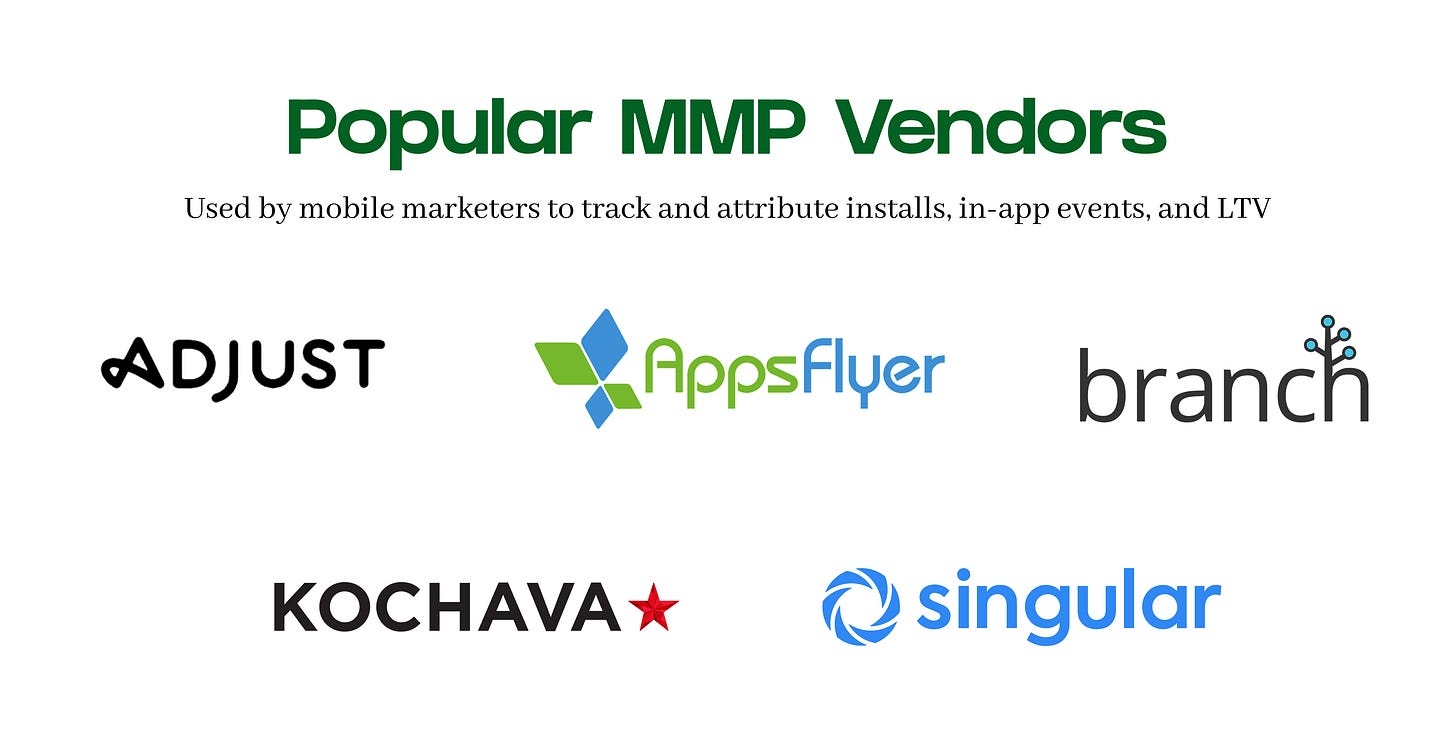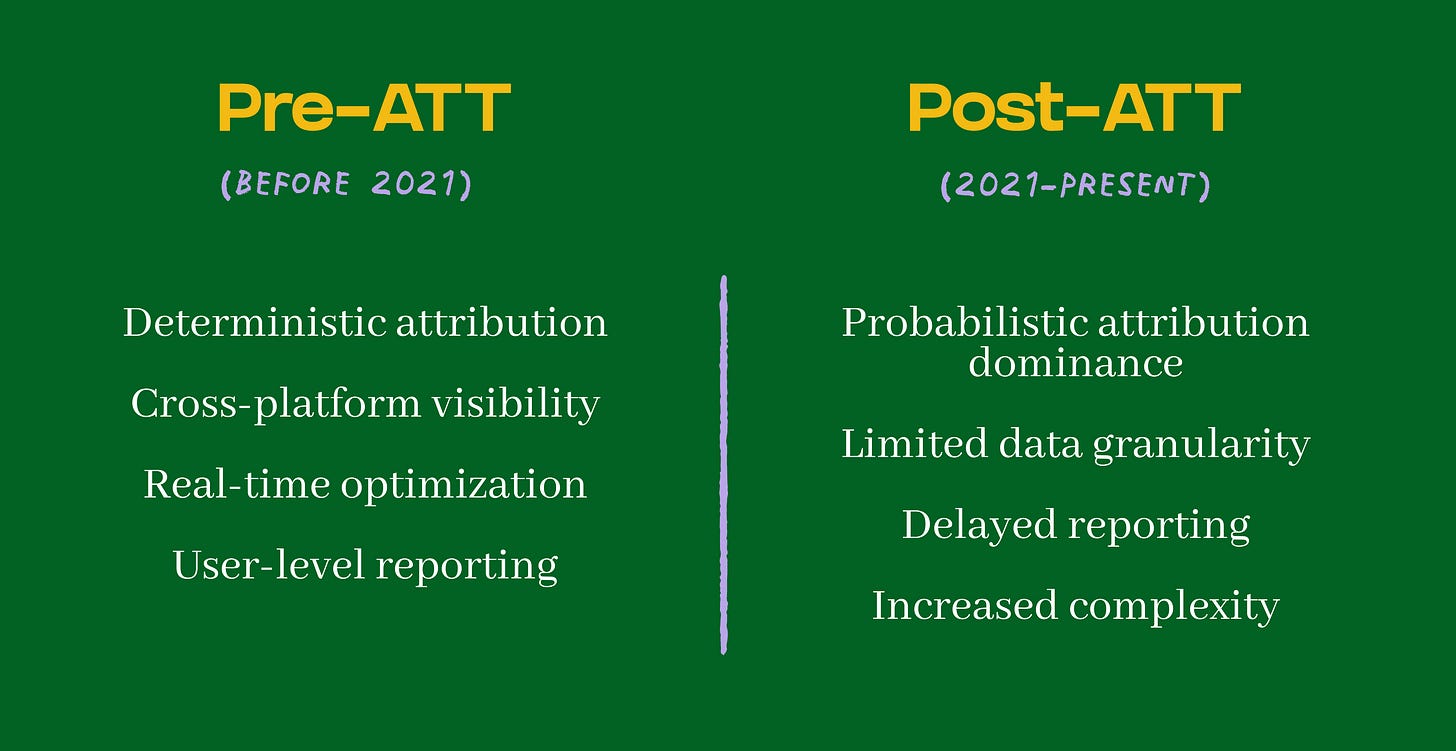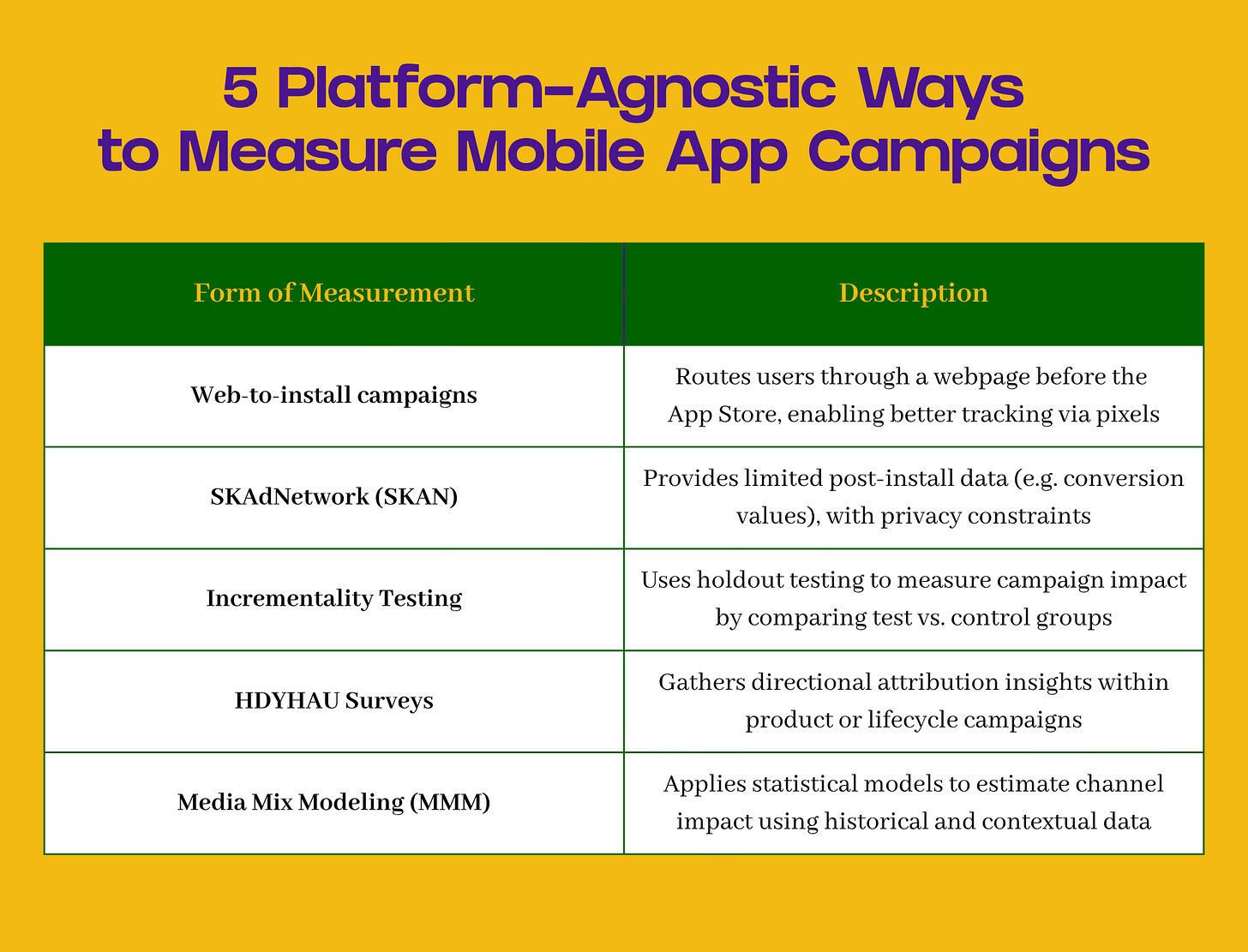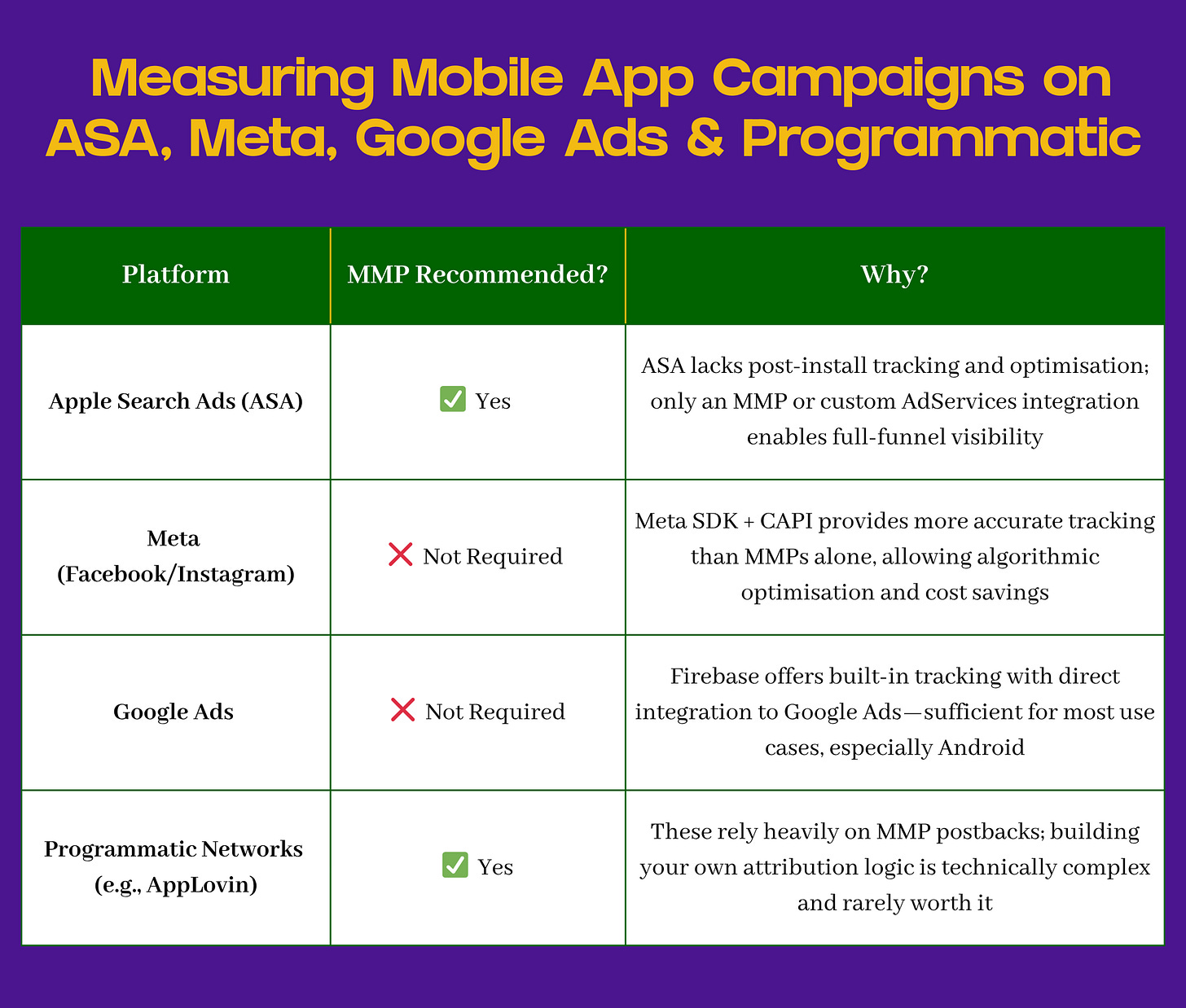Do You Still Need an MMP in 2025? Attribution alternatives for measuring paid campaigns in a post-ATT world
We cover how to measure mobile install campaigns with and without a third-party Mobile Measurement Partner on Google Ads, Meta Ads, Programmatic and other channels.
First things first, I’d like to thank Thomas Petit (ex-RevenueCat, Deezer), Lucas Moscon (Appstack, RevenueCat), Leonardo Ubbiali (ex-Moonpay and Babylon), Daniel Ferreira (Artefact, ex-Publicis), and Igor Castanho (ex-Olist) for reading drafts of this, giving feedback and helping me write the most comprehensive non-MMP guide I could.
The Measurement Mayhem We're Living In
Let's face it: the mobile marketing ecosystem has been turned upside down since Apple dropped the App Tracking Transparency (ATT) bomb in 2021. What was once a relatively straightforward process of tracking user journeys from ad impression to in-app purchase has become a chaotic scavenger hunt for reliable data.
For growth teams managing substantial media budgets, this has created a frustrating reality: those attribution tools you've relied on for years—the ones your boss is still expecting pristine reports from—simply aren't providing the same level of certainty they once did. Yet your CEO still wants to know exactly which campaigns are driving revenue, preferably by yesterday.
This guide explores how sophisticated marketing teams can measure and optimize mobile app campaigns without defaulting to an MMP, providing platform-specific approaches and their genuine business implications. While centralizing attribution through an MMP remains valuable for many organizations (and keeps things simpler), understanding these alternative approaches offers several competitive advantages:
Privacy resilience: Building first-party measurement infrastructure creates protection against further privacy changes (and trust me, they're coming)
Cost efficiency: Reducing dependence on third-party attribution tools can significantly lower costs
Enhanced data ownership: Direct implementation gives you more control over your measurement methodology
Platform-specific optimization: Tailored approaches for each channel can yield better performance than one-size-fits-all attribution
First things first: What is an MMP?
Mobile Measurement Partners (MMPs) are specialized analytics platforms that help app marketers track and attribute user acquisition across advertising channels. Popular MMPs include Adjust, AppsFlyer, Branch, Kochava, and Singular. These platforms traditionally served as the single source of truth for attribution data, helping marketers understand which ads led to app installs and subsequent in-app actions.
A key advantage of MMPs is their ability to provide centralized attribution that handles deduplication across campaigns. When users interact with multiple channels during their journey (for example, seeing both a Google and Meta ad before installing), MMPs apply attribution models to credit the appropriate source. This deduplication capability is difficult to replicate with platform-specific attribution solutions.
The Post-ATT Reality: How MMPs Have Changed
Before diving into platform-specific approaches, let's acknowledge how fundamentally different MMPs are in our new privacy-centric reality.
Pre-ATT World (Before 2021)
Mobile Measurement Partners like Adjust, AppsFlyer, and Branch operated with remarkable precision in the pre-ATT world:
Deterministic attribution: MMPs could directly link ad interactions to app installs and post-install events using device identifiers (IDFA on iOS, GAID on Android)
Cross-platform visibility: User journeys could be tracked across channels, allowing for sophisticated multi-touch attribution
Real-time optimization: Ad platforms received granular conversion data, enabling algorithmic optimization toward high-value users
User-level reporting: Marketers could analyze individual user behaviors, LTV calculations, and cohort performance
Post-ATT World (2021-Present)
The introduction of App Tracking Transparency fundamentally altered this landscape:
Probabilistic attribution dominance: With IDFAs largely unavailable, MMPs shifted to probabilistic methods using IP addresses, timestamps, and device characteristics to make educated guesses about attribution
Limited data granularity: Privacy thresholds and conversion values significantly restrict the depth of information available
Delayed reporting: Real-time optimization has been replaced by aggregated, delayed reporting windows
Increased complexity: Implementation now requires platform-specific knowledge and ongoing maintenance
For marketing teams, this means MMPs have transformed from comprehensive attribution solutions to integration layers that aggregate data from various platform-specific measurement technologies—often at significant cost but with diminishing unique value.
Platform-Agnostic Measurement Approaches
Some ways of measuring mobile app campaigns work regardless of the platform.
Option 1: Web-to-install campaigns
For most of the cases in this article, we’re referring to traditional “install” campaigns that take the user directly to the App Store listing. However, taking the user to a web page first is an alternative that can decrease acquisition costs while also improving measurement. In this case, you can use:
Ad Platform tags (like Meta and Google conversion pixels)
APIs (like CAPI)
Option 2: SKAdNetwork (SKAN)
SKAdNetwork provides some post-install data but with significant limitations:
Allows tracking of conversion values (0-63) that can encode basic user behavior
Provides campaign ID but no keyword-level data
Subject to privacy thresholds that further limit reporting
Requires specialized implementation knowledge
It can be leveraged alongside deterministic-attribution (an MMP or a custom-built solution) to create a deduplicated one-view reporting.
Option 3: Incrementality Testing
For larger organizations with sufficient campaign volume, incrementality testing offers a method to measure impact of different initiatives.
Identify geographic regions with similar characteristics
Run ASA ampaigns in test regions while keeping control regions dark
Measure the lift in overall conversions between test and control regions
Calculate the incremental impact of campaign spending
This approach requires:
Significant campaign volume
Statistical expertise for proper test design and analysis
Patience, as results aren't available in real-time
Option 4: "How Did You Hear About Us" (HDYHAU) Surveys
While less technical, implementing in-app surveys can provide directional insights:
Prompt new users with a simple survey asking how they discovered your app
Track responses mentioning for example "App Store Search" or similar terms
Compare survey data with ASA spend to estimate efficiency
This method is most valuable as a directional signal rather than precise attribution. You can also get around a product implementation by emailing new users a survey. I’ve personally done this before, and it’s a great starting point.
Option 5: MMM (Media Mix Modeling)
Media Mix Modeling offers a holistic approach to understanding marketing effectiveness across channels:
Uses statistical analysis to determine marketing impact on key business outcomes
Measures effectiveness across all channels, including those with limited direct attribution
Should account for external factors like seasonality, market conditions, and competitor activity
Implementation can be done through specialized MMM vendors or in-house data scientists, often leveraging open-source frameworks like Meta's Robyn.
MMM isn't for everyone. It typically requires 1-2 years of historical data across multiple channels and significant analytical resources, making it better suited for established apps with diverse marketing strategies.
Platform-Specific Measurement Approaches
Let's examine how to effectively measure campaigns on each major platform without an MMP, including implementation requirements and business implications.
Apple Search Ads (ASA): The Measurement Enigma
Apple Search Ads presents perhaps the most challenging measurement scenario without an MMP, as its core functionality focuses exclusively on install attribution with no native capacity for tracking downstream events like trials or purchases.
Technical Implementation
Apple Search Ads provides basic install attribution out-of-the-box through a proprietary matching system that doesn't require user opt-in. However, there are several critical limitations:
Install-only optimization: ASA campaigns can only optimize for installs, not downstream conversions like trials or purchases—regardless of whether you use an MMP
No feedback loop: Unlike other platforms, there's no native mechanism to send conversion data back to ASA for optimization purposes
Limited keyword insights: Without downstream conversion data, it's impossible to determine which keywords drive meaningful business outcomes versus merely generating installs
For organizations needing more robust ASA measurement, the only MMP alternative for measuring deterministic post-install behaviour (downstream conversion data) is to build something custom.
AdServices API (Custom Integration)
The AdServices framework offers the most comprehensive solution, as this is the same API that MMPs themselves builds on top of. It requires significant development resources, but on the other hand I’ve also seen in FixMyTracking development teams run around in circles trying to understand why MMPs are not working as intended.
This implementation allows you to:
Deterministically attribute installs to specific ASA campaigns
Connect user activity to the originating campaign
Build custom reporting based on this attribution
However, it requires:
iOS development resources
Backend infrastructure for token validation
Regular maintenance as Apple updates the framework
Meta (Facebook & Instagram): The SDK+CAPI Power Couple
Unlike ASA, Meta offers multiple viable options for measurement without an MMP, with a hybrid approach providing the most comprehensive solution.
Meta SDK + Conversions API Hybrid Approach
This approach combines client-side tracking via Meta's SDK with server-side events through the Conversions API, providing comprehensive measurement across the user journey:
Tracks app installs and early funnel events directly in the app
Captures user engagement metrics that require on-device context
Tracks high-value events like trials and purchases server-side
Sends conversion data directly from your servers to Meta
Leverages PIII (like user emails) to enhance attribution
RevenueCat Integration:
RevenueCat already tracks subscription events
Configure RevenueCat to send events to Meta CAPI
Establish a robust data pipeline from RevenueCat to BigQuery for analysis
The hybrid approach provides several advantages:
More comprehensive coverage than using an MMP alone
Redundancy in tracking critical conversion events
Higher match rates by combining multiple identification methods
And, if you rely on SKAN, using Meta’s SDK means Meta controls how conversion values are set—making optimization easier but limiting your visibility. With an MMP SDK, you define the conversion value logic yourself, giving you more transparency and flexibility across ad channels.
Advantages of CAPI over client-side tracking (MMP or SDK)
Regardless of whether you’re deciding whether to SDK or MMP, conversion tracking with APIs provide unique advantages for campaign optimization.
Greater control over what data you share: With the Conversions API, you choose exactly which events and user data to send to Meta, aligning with both business goals and privacy requirements.
Flexible event timing: Unlike client-side SDKs or MMP postbacks, CAPI lets you send events after the moment they occur—perfect for lead scoring, onboarding milestones, or any conversion logic that depends on post-signup behavior.
Business Impact
The stakes for proper Meta measurement are extraordinarily high:
The Algorithm Optimization Gap: Meta's algorithms are only as good as the data you feed them. Without proper conversion tracking, you're essentially asking Meta to optimize for the wrong outcomes. In practice, this means paying premium CPMs for users who install but never convert.
Real-World Consequences: One wellness app I worked with discovered they were losing approximately 40% of attributable conversions by relying solely on Meta's SDK without the Conversions API complement. Their actual CAC was substantially lower than reported, and they had been unnecessarily constraining growth based on incorrect data.
Campaign Performance Impact: When another client implemented the SDK+CAPI hybrid approach, they saw a 22% decrease in cost-per-trial within two weeks—not because their actual performance improved, but because Meta's algorithms finally had accurate data to optimize against. Their growth team had been fighting an uphill battle with incomplete data for months.
The bottom line: if Meta represents a significant portion of your acquisition budget, implementing proper conversion tracking isn't optional—it's the difference between scaling profitably and potentially killing campaigns that are actually performing well. You can’t rely on MMP alone.
Other social platforms
Over the last years, other social ad platforms have been following Meta’s route and launching their own CAPIs too. That is the case for TikTok’s Events API and Pinterest’s API.
Google: Built-in Solutions Already Available
Google provides the most straightforward MMP alternative through its Firebase platform:
Firebase Analytics can track installs and in-app events
Integration with Google Ads provides attribution for app campaigns
Data flows into BigQuery for cross-platform analysis
If you're already using Firebase, you likely have the foundation for Google Ads measurement without an MMP. The key challenge isn't implementation but ensuring proper monitoring and troubleshooting frameworks to maintain data accuracy and catch potential errors.
For Google Ads web campaigns (which you might explore in the future), Google Analytics would be the primary tracking mechanism. Both Google Analytics and Firebase feed data into BigQuery, allowing you to analyze performance across platforms in a single environment.
Business Impact
The Firebase approach to Google Ads measurement offers several business advantages:
Direct Algorithmic Feedback: Unlike some platforms, Google Ads can directly utilize Firebase conversion data for optimization, creating a tight feedback loop that improves campaign performance. Keep in mind Google owns both sides (Firebase and Ads), and in cases you’re advertising Android—well, they also own that.
Cost Efficiency Without Compromise: Firebase provides measurement capabilities that rival most MMPs for Google campaigns at no additional attribution cost. One gaming client realized they were spending over $100,000 annually on an MMP that was primarily being used for Google Ads campaigns—all of which could have been tracked effectively through Firebase.
Enhanced First-Party Data Collection: Because Firebase data flows directly into BigQuery, marketing teams gain richer insights beyond simple attribution, including behavioral patterns that can inform product development and retention strategies.
tROAS campaigns: You can only run Google Ads tROAS campaigns if you’re using Firebase. Otherwise, you’re stuck with tCPA. This is Google’s “carrot” way of onboarding companies on Firebase.
However, if you’re using something else than Firebase for product analytics (e.g. Mixpanel, Amplitude), then supporting Firebase just for the Google Ads use case and don’t plan on running tROAS, this could not be the best use of resources.
Programmatic Networks (e.g., AppLovin): The Most Challenging Case
Programmatic networks like AppLovin present the most difficult measurement scenario without an MMP:
These networks rely heavily on postback systems between MMPs and their platforms
AppLovin has an SDK, but it's for publishers (apps that want to monetize by showing ads), not for tracking install attribution
Creating your own solution would require building:
Click Tracking + Attribution Logic
Capture user identifiers from ad clicks (device ID, click ID)
Match these clicks to the user using your own logic on app open or install
Event Tracking + Real-Time Postbacks
Log in-app events (like purchases) in your backend
Send these events back to AppLovin via server-to-server (S2S) postbacks in near real-time
This represents significant technical complexity similar to building your own mini-MMP—likely not justified unless you're spending millions on these networks.
Making the Decision: MMP vs. Alternative Solutions
When deciding whether to continue using an MMP in 2025, consider:
Ad platform mix: If you're heavily invested in programmatic networks, an MMP may still be necessary. If you're primarily using Google and Meta, alternatives are more viable.
Technical resources: Building and maintaining non-MMP attribution systems require development resources and ongoing maintenance. Engineering teams often have an inherent bias toward building custom solutions, so take these recommendations with a grain of salt when evaluating the true cost.
Measurement priorities: If campaign-level ROAS is sufficient (vs. creative or keyword-level), simpler attribution models may work.
Budget considerations: It's very difficult to troubleshoot install attribution, so the math will usually skew toward purchasing an MMP. Most MMPs charge per paid install, so costs scale linearly with spend, making it more cost-efficient than dedicating valuable engineering resources to building and QA-ing custom solutions.
Data infrastructure: Strong data warehouse capabilities make alternative solutions more feasible by allowing you to centralize and analyze data from multiple sources.
For many companies with moderate budgets focused on major platforms, a hybrid approach may work best—using platform-specific solutions for Google and Meta while using an MMP primarily for programmatic networks or considering whether to invest in these channels at all given the measurement challenges.
There’s no perfect way forward
The reality is that perfect attribution no longer exists in the post-ATT world, whether you use an MMP or not. While ATT has primarily affected iOS, the impact is significant given that iOS accounts for the majority of app revenue globally. With Google's Privacy Sandbox on the horizon for Android, the attribution landscape will continue to evolve.
The key is matching your measurement approach to your specific marketing mix, technical capabilities, and business objectives. For many companies, the centralized attribution and deduplication capabilities of MMPs still provide value that outweighs their cost, particularly when factoring in the engineering resources required to build and maintain alternative solutions.
Whatever approach you take, focus on establishing frameworks for monitoring and troubleshooting to ensure data accuracy, as the technical implementation is just the beginning of maintaining reliable attribution in a privacy-first world.






